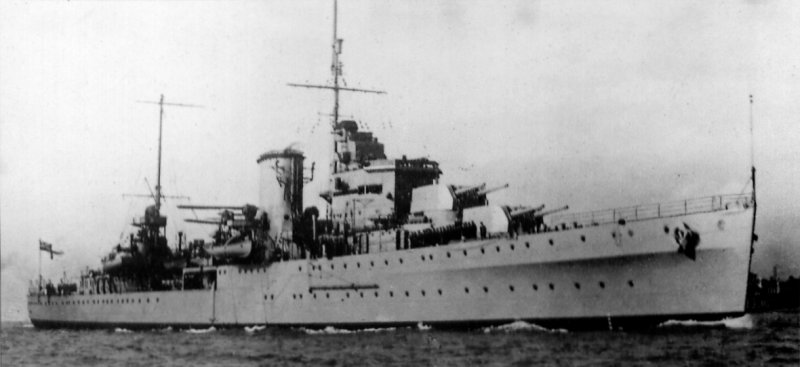HMS Ajax (22)
 |
|
| History | |
|---|---|
|
|
|
| Name: | HMS Ajax |
| Builder: | Vickers Armstrong, Barrow-in-Furness |
| Laid down: | 7 February 1933 |
| Launched: | 1 March 1934 |
| Commissioned: | 3 June 1935 |
| Recommissioned: | 11 January 1938 |
| Decommissioned: | February 1948 |
| Identification: | Pennant number: 22 |
| Motto: | Nec Quisquam Nisi Ajax (Latin: "None but Ajax can overcome Ajax") |
| Fate: | Scrapped in 1949 |
| General characteristics | |
| Class and type: | Leander-class light cruiser |
| Displacement: |
|
| Length: | 554.9 ft (169.1 m) |
| Beam: | 56 ft (17 m) |
| Draught: | 19.1 ft (5.8 m) |
| Installed power: | 72,000 shaft horsepower (54,000 kW) |
| Propulsion: |
|
| Speed: | 32.5 knots (60 km/h) |
| Range: | 5,730 nmi (10,610 km; 6,590 mi) at 13 knots (24 km/h; 15 mph) |
| Complement: |
|
| Sensors and processing systems: |
|
| Armament: |
|
| Armour: |
|
| Aircraft carried: | One catapult-launched Fairey Seafox, replaced by a Supermarine Walrus |
| Service record | |
| Operations: |
|
HMS Ajax was a Leander-class light cruiser which served with the Royal Navy during World War II. She became famous for her part in the Battle of the River Plate, the Battle of Crete, the Battle of Malta and as a supply escort in the Siege of Tobruk. This ship was the eighth in the Royal Navy to bear the name. In February 1942, she was adopted by the civil community of Halifax.
Ajax was built at Vickers' shipyard, in Barrow-in-Furness, England. She was laid down on 7 February 1933, launched on 1 March 1934 and completed on 12 April 1935. She was commissioned for service on the North America and West Indies Station, but after working up in May 1935, she was deployed instead to the Mediterranean on detached service after the Abyssinian crisis. This lasted until November when she finally joined her squadron in Bermuda. Until 1937 she undertook exercises and visits to ports in the Americas. At the end of her West Indies deployment, Ajax returned to Britain for refit. At this time, her 4" battery was upgraded by exchanging single for double mountings.
She rejoined her squadron in the West Indies in February 1938 and remained on that station until 1939 when she was redeployed to the Pacific, off South America. On 27 January, Ajax went to assist the rescue of earthquake victims at Talcahuano, in Chile. She then returned to Bermuda and was redeployed to the South Atlantic Division in March.
When war was declared in September 1939, Ajax took up her appropriate station and patrolled off the River Plate. There she sank the German merchant ship Olinda on 3 September. She intercepted the German merchantman Carl Fritzen and the passenger ship Ussukuma (with the cruiser HMS Cumberland) on 4 and 5 September, respectively. Both ships scuttled themselves to avoid capture.
...
Wikipedia
